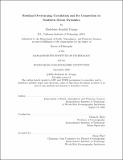Residual overturning circulation and its connection to Southern Ocean dynamics
Author(s)
Youngs, Madeleine Kendall.
Download1227036952-MIT.pdf (12.79Mb)
Other Contributors
Joint Program in Physical Oceanography.
Massachusetts Institute of Technology. Department of Earth, Atmospheric, and Planetary Sciences.
Woods Hole Oceanographic Institution.
Advisor
Glenn R. Flierl.
Terms of use
Metadata
Show full item recordAbstract
Over the last 20 years, our understanding of the meridional overturning circulation has improved, but primarily in a two-dimensional, zonally-averaged framework. In this thesis, I have pushed beyond this simplification and shown that the additional complexity of meanders, storm tracks, and other zonal asymmetries is necessary to reproduce the lowest-order behavior of the overturning circulation. First I examined the role of basin width for determining whether the Atlantic or Pacific oceans experience deep convection. I used a two layered model and a rectangular single-basin model to show that the basin width, in combination with scalings for the overturning circulation make the overturning relatively weaker in the wider basin, priming it for a convection shut down. In addition to this large-scale work, I have examined Southern Ocean-like meanders using a hierarchy of idealized models to understand the role of bottom topography in determining how the large-scale circulation responds to climate change scenarios. These are useful because they preserve the lowest-order behavior, while remaining simple enough to understand. I tested the response of the stratification and transport in the Southern Ocean to changes in wind using a highly-idealized two-layer quasi-geostrophic model. In addition to showing that meanders are necessary to reproduce the behavior of the Southern Ocean, I found that strong winds concentrate the baroclinic and barotropic instabilities downstream of the bottom topography and weaken the instabilities elsewhere due to a form-drag process. With weak winds, however, the system is essentially symmetric in longitude, like a flat-bottomed ocean. This result is consistent with observations of elevated turbulence down-stream of major topography in the Southern Ocean. My next study investigated a more realistic Southern Ocean-like channel, with and without bottom topography, and examined the three-dimensional circulation in order to understand where vertical transport occurs and develop a picture of the pathways taken by each individual water parcel. I found that the vertical transport happens in very isolated locations, just downstream of topography. Finally, I added a biogeochemical model to my simulations and found that carbon fluxes are enhanced near topography, again highlighting the role of zonal asymmetries.
Description
Thesis: Ph. D., Joint Program in Physical Oceanography (Massachusetts Institute of Technology, Department of Earth, Atmospheric, and Planetary Sciences; and the Woods Hole Oceanographic Institution), 2020 Cataloged from student-submitted PDF of thesis. Includes bibliographical references (pages 135-145).
Date issued
2020Department
Joint Program in Physical Oceanography; Massachusetts Institute of Technology. Department of Earth, Atmospheric, and Planetary Sciences; Woods Hole Oceanographic InstitutionPublisher
Massachusetts Institute of Technology
Keywords
Joint Program in Physical Oceanography., Earth, Atmospheric, and Planetary Sciences., Woods Hole Oceanographic Institution.